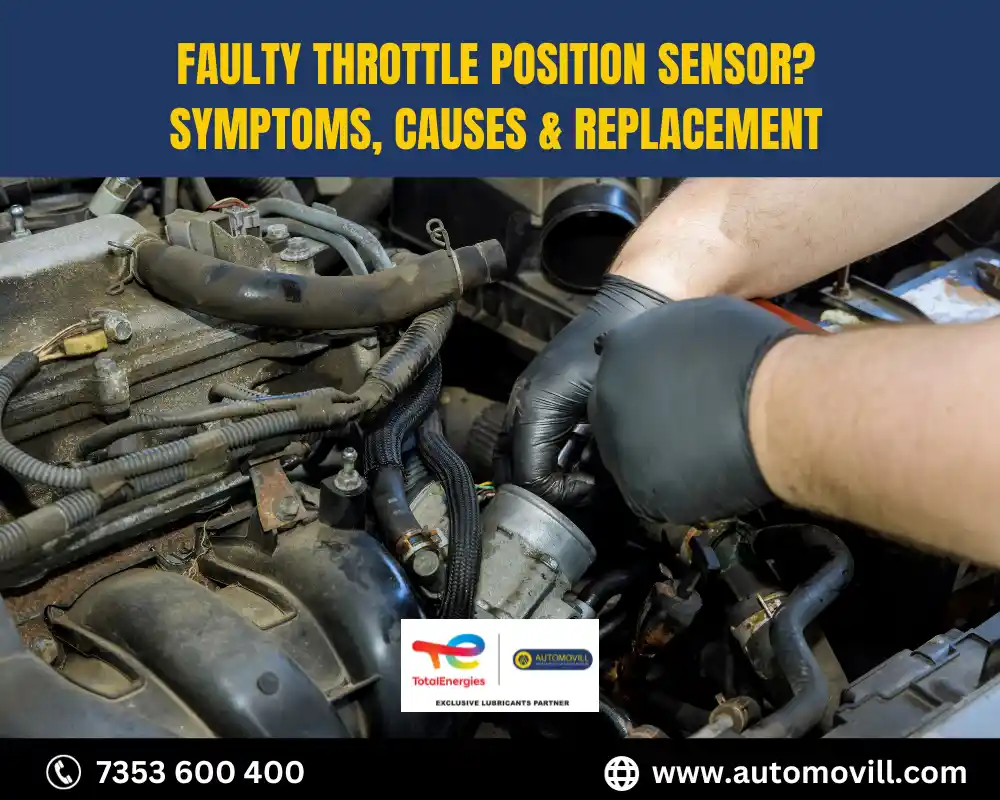
The throttle position sensor (TPS) is a crucial component in your vehicle’s engine to monitor and control the fluid flow in the engine for optimal fuel efficiency, performance, and smooth operation.
It adjusts the air-fuel mixture and ignition timing for optimal performance.
When the throttle position sensor becomes faulty, it can lead to a range of problems that affect your vehicle’s drivability.
In this blog, we’ll discuss the symptoms of a failing TPS, its causes, and the replacement process to help you keep your vehicle running smoothly.
Throttle Position Sensor Symptoms
A faulty throttle position sensor can manifest a variety of symptoms, making it important to recognize them early to avoid further damage. Here are some common symptoms of a failing TPS:
- Poor Acceleration: One of the primary functions of the TPS is to relay throttle position data to the engine control unit (ECU). When it malfunctions, you may experience sluggish acceleration and reduced engine response.
- Idle Problems: An unstable or rough idle is often a sign of a bad TPS. Your vehicle may struggle to maintain a consistent idle speed or even stall when coming to a stop.
- Hesitation or Surging: Inconsistent throttle response, including hesitation or surging during acceleration, can be attributed to TPS issues. You might notice jerky movements while driving.
- Poor Fuel Efficiency: A failing TPS can lead to an improper fuel-air mixture, resulting in reduced fuel efficiency. You may find yourself visiting the gas station more often than usual.
- Check Engine Light (CEL): In many cases, a malfunctioning TPS triggers the check engine light on your dashboard. It’s important not to ignore this warning, as it can help diagnose the issue early.
Causes of Throttle Position Sensor
Understanding the common causes of TPS issues can help prevent them in the future. Here are some factors that can lead to throttle position sensor problems:
- Wear and Tear: Like any other automotive component, the TPS can wear out over time due to regular use and exposure to engine heat.
- Contaminants: Dust, dirt, and oil can accumulate on the sensor, affecting its accuracy and performance.
- Electrical Problems: Wiring or connector issues, including corrosion or loose connections, can disrupt the signal between the TPS and the ECU.
- Improper Installation: Incorrect installation or adjustment of the TPS during maintenance or repair work can lead to problems.
What Happens When the Throttle Position Sensor Goes Bad?
When a TPS fails completely or its performance is severely compromised, it can lead to a range of issues with your vehicle. Here’s what can happen when the throttle position sensor goes bad:
- Reduced Performance: Your vehicle may struggle to accelerate, and overall performance will be compromised. This can be not only frustrating but also dangerous in certain driving situations.
- Decreased Fuel Efficiency: A malfunctioning TPS can disrupt the proper air-fuel mixture, causing your vehicle to consume more fuel than necessary.
- Stalling or Rough Idling: A bad TPS can cause your engine to stall at idle or when coming to a stop, making it challenging to drive in traffic.
- Increased Emissions: A malfunctioning TPS can lead to higher emissions, potentially causing your vehicle to fail emissions tests.
Replacement of the Throttle Position Sensor
Replacing a faulty throttle position sensor is essential to restore your vehicle’s performance and drivability. Here are the general steps to replace a TPS:
- Gather the necessary tools: You’ll typically need a socket set, a screwdriver, and a replacement TPS.
- Locate the TPS: The TPS is usually located on the throttle body or near the throttle pedal, depending on your vehicle’s make and model.
- Disconnect the battery: For safety reasons, disconnect the vehicle’s battery to prevent any electrical mishaps during the replacement.
- Remove the old TPS: Carefully disconnect the electrical connector and remove any mounting screws or bolts holding the TPS in place.
- Install the new TPS: Attach the new TPS in the same position as the old one, securing it with the mounting screws or bolts.
- Connect the electrical connector: Ensure the connector is properly attached.
- Reconnect the battery: Reconnect the vehicle’s battery, and start the engine to test for proper operation.
- Clear error codes: If the check engine light was triggered, use an OBD-II scanner to clear any error codes.
If you’re not comfortable performing this replacement yourself, it’s advisable to seek professional help to ensure the job is done correctly.
Throttle Troubles? Reboot Your Ride!
Don’t let a failing throttle position sensor hamper your vehicle’s performance.
If you’re experiencing any of the symptoms mentioned above, it’s time to take action. Whether you’re a DIY enthusiast or prefer professional assistance, addressing TPS issues promptly is crucial.
Call or Schedule Your Repair Now with Automovill as we promised:
✅ Super Skilled Mechanics
✅ Latest Automated Tools to Diagnose the Issue
✅ Fair Pricing and No Hidden Charges
✅ Free Pick & Drop
Your vehicle and your wallet will thank you for it!
